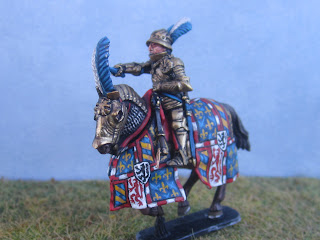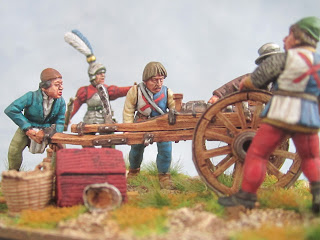Master WA illustration (detail) c 1475
In planning my Burgundian Coustillers, I recently made a
close inspection of a woodcut illustration of mounted soldiers
made by the ‘Master WA’. It is one of a series of images understood to show Burgundian
soldiers of around 1475; the one most widely reproduced
being a row of longbowmen protected by stakes and supported by a rear rank of halberdiers.
The images of mounted troops shows men in half armour and helms carrying lances
or long spears riding unbarded horses, supported by two further ranks of
crossbow-armed horsemen – detail from one is shown above.
I’d not expected the rear ranks to be crossbowmen and had
always assumed that all were spear armed coustillers. Coupled with this, other
recent contemporary illustrations from the later fifteenth century I’ve looked
at, also appears to show mounted crossbowmen fighting closely alongside
lance-armed men at arms. This has got me thinking about what was the tactical use
of mounted crossbows in the later medieval period?
Now the rest of this post comes with a major health warning.
All of the following initial thoughts are based solely on observations of
selected medieval illustrations. I have had no access to any primary documents regarding the tactical use of mounted crossbows – although at present
I’m not aware that there may be any. It is of course very dangerous to make
sweeping assumptions based merely on surviving illustrations. Most medieval
artists were unlikely to have had any first-hand experience of warfare –
although there are notable exceptions in Diebold Schilling (d 1485) and Urs
Graf (d 1528). I’m fully aware of illuminations, such as Froissart’s Chronicles,
which show longbows being loosened from horseback in battle which seems an
unlikely practice, so using imagery on
which to base conclusions is fraught with danger.
However, some reading of secondary materials that I have on
fifteenth century warfare does seem both inconclusive and slightly vague on
what the battlefield role of mounted crossbowmen was. Numbers of troops classed
as 'mounted crossbowmen’ seem to be relatively high as the fifteenth century progressed, particularly in Italy and
France (as part of the 'lance'). How they acted in combat is unclear - although it seems they were primarily mobile
infanty, such as mounted English longbowmen appear to have been. Nicole in Osprey's 'European Medieval Tactics 2' suggests that the large numbers noted in Italy were largely foot troops, operating in conjunction with pavisers on the battlefield -with a skirmishing role, screening other troops who were
vulnerable to missle fire. Mallet in 'Mercenaries and Masters' notes that crossbowmen were mounted only for campaigning and formed separate dismounted units on the battlefield. It
appears that the preference was to employ Stradiots from the Balkans for the role of skirmishing in an engagement, rather than mounted crossbowmen.
So as mounted crossbowmen are available to select in almost all
wargame rule army lists for later medieval armies in western Europe (English
ones excepted), usually classed as ‘Light Cavalry’ and in a skirmishing role - do we have an apparent disconnect with actual practice.
Could crossbowmen have fought effectively from horseback? My view is most
probably they could. Crossbows were widely used for hunting on horseback and are shown
as such in illustrations throughout the medieval period; however on the battlefield loading the bow
swiftly, whilst remaining on the horse was essential. Following the
widespread introduction of the cranequin from circa 1460, this scenario appears
to have been more realistic.

This device allowed a rider to remain in the
saddle and use handheld winding device to pull the string against the firing nut
(often at a high tension) without having to use a stirrup to brace the bow.
Several illustrations show crossbowmen on horse both with cranequins
and firing crossbows.
An intriguing
illustration from Germany of circa 1465 shows a possible tactic,
mimicking the ancient ‘Parthian shot’, of shooting behind the rider. How
accurate this type of shot would be is debatable however.
Hans Talhoffer illustrations c 1467
So what of other illustrations? Are there any which appear
to complement the Master WA drawing of a combined lance and crossbow mounted
contingent, rather than as the mounted skirmishers of wargame army lists? Closer investigation of Schilling’s illustrations for the Bernese Chronicles is interesting and consistently shows several battle scenes where
plate armoured men at arms and
plate armoured crossbowmen are fighting
alongside each other. In some a potential coustiller-type, armed with tasselled spear and brigandine, is even shown in a supporting role (see middle image below). Were these images drawn to
reflect what Schilling had observed firsthand in the Bernese wars? Was the
inclusion of heavily armoured crossbowmen within groups of men at arms a common
sight? Is this how the French-originated 'lance' performed on the battlefield - as an integrated unit of all the mounted arms, rather than each type (man at arms, coustiller and crossbowman) being split up and fighting together dictated by the weapon they carried? Certainly there's a logic to maintaining cohesion on the field by retaining the 'lance's' composition and duties of service and support to the man arms in the fighting.
Berne Spiezer chronicle c 1485
Berne chronicle (volume 3) c 1480
In the woodcut of the battle of Dornach in 1499 there is more apparent evidence of crossbows supporting closely a cavalry charge made by Swiss against Imperialist forces.

Battle of Dornach. detail of woodcut, 1499 (British Library)
Also the 'Housebook Master' shows mounted troops both on the march and practising arms as an apparent combined group of lance and crossbow armed soldiers.
Master of the Housebook (detail) c1475
Tactically could such a fighting combination of lance and
crossbow have worked? The main effectiveness of a lance is its initial impact
and the impetus of a frontal assault by armoured men riding horses at a canter
or gallop. In such an attack crossbowmen may not have been involved; it maybe
doubtful if they could shoot from a second rank before contact was made.
However should men at arms be involved in a follow-up melee, the inclusion of
crossbowmen, shooting a relatively close range with armour-piercing bolts, may
have been effective. It’s tempting to imagine from such illustrations, the use
of mounted crossbowmen as almost a precursor to 16
th century
caricole
tactics with pistols, although having a reduced impact by being dispersed among
men at arms rather than employed en masse. Their use at such close quarters
would also require the amount of full plate and armour in which Schilling
consistently shows them.
What do these idle and incomplete thoughts mean for my
wargames army? Well, I’m going to mix some crossbows in with my Burgundian
coustillers, who’ll support the men at arms as a secondary row of mounted
troops. It gives me a good excuse for varying the figures in the unit and
painting some of the Perry Italian castings. I’ll also have some reference points to defend
myself when someone inevitably challenges me!
How I’ll deal with them in any rules may well be the subject
of another posting….


















































